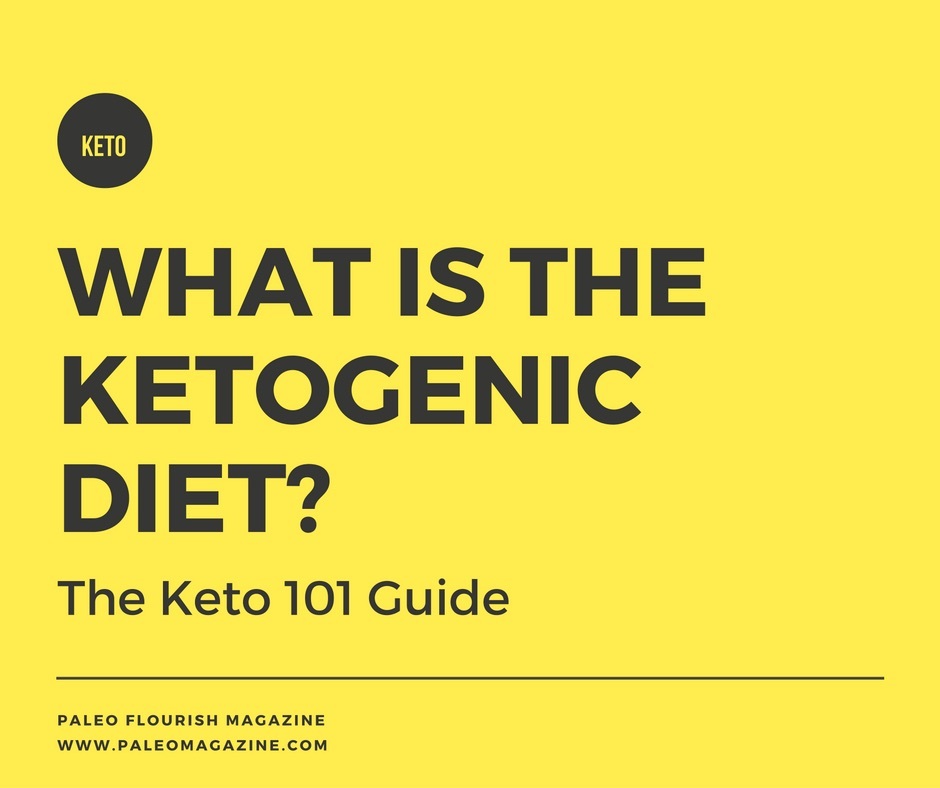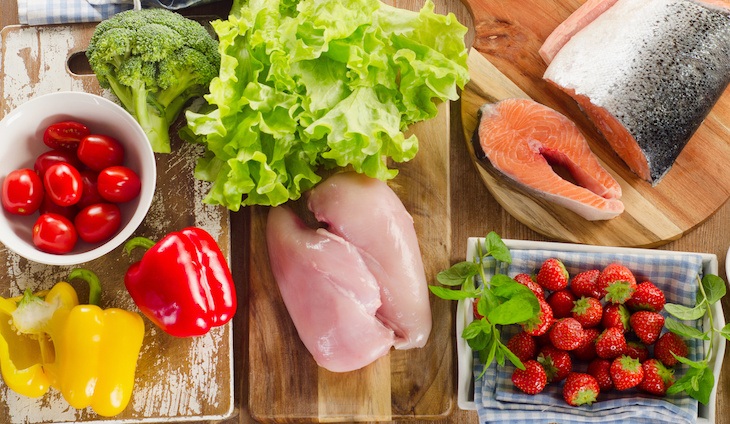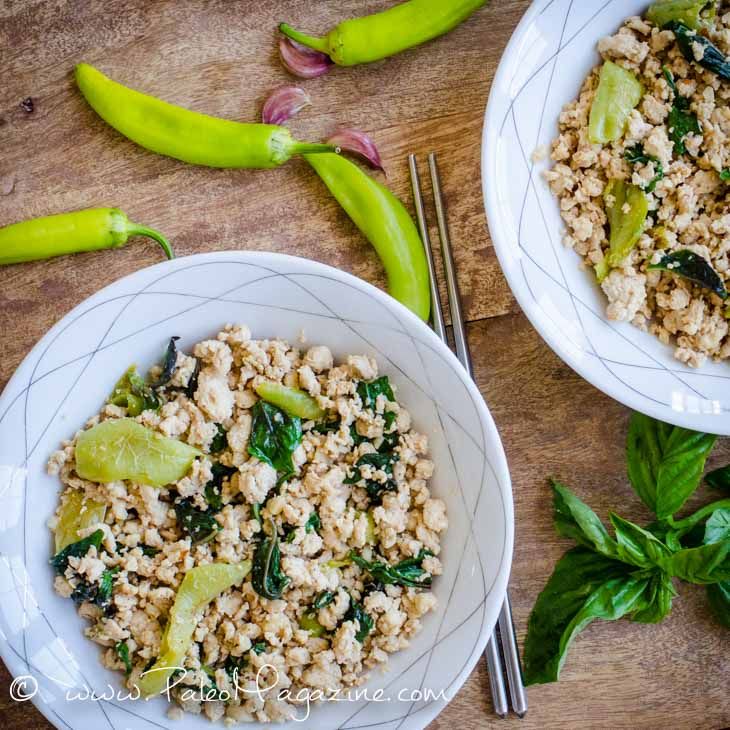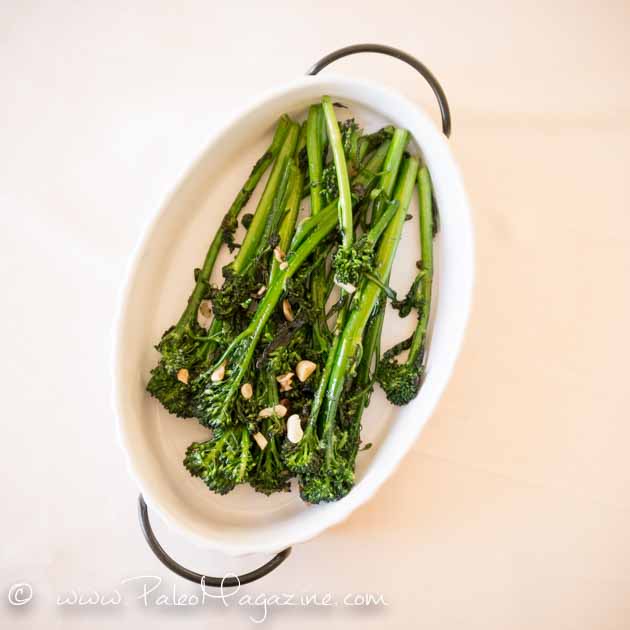What is the Ketogenic Diet? – Your Keto 101 Guide

I’ll start with a quick answer to “what is the ketogenic diet?” before diving into the intricacies of this diet.
Definition of Ketogenic Diet:
The ketogenic diet (AKA keto diet, ketosis diet) is a low carbohydrate diet designed to put your body into the natural state of nutritional ketosis. When your body receives very few carbohydrates, it can’t use glucose to supply all your energy needs. So your body’s fat cells will be broken down in your liver to produce ketones (ketone bodies). Your body will then use those ketones for energy.
Dr. Stephen Phinney, M.D. from Virta Health expands on this. “Nutritional ketosis is a natural metabolic state in which your body is fueled mainly by fats and ketones, instead of carbohydrates (glucose). Nutritional ketosis happens when carbohydrate consumption goes low enough that a person’s liver can convert adipose tissue and dietary fats into a fatty acid known as ketones, then burn the ketones for energy.”
In this article, I’ll go over some of the basics of a ketogenic diet like what do you eat, will you lose weight, how do you measure ketones. I’ll also reference other articles so that you can (if you want) go into more depth.
Before you really dig into specifics, you can check out this quick 5-minute recap of the diet:
Table of Contents – Keto 101 Guide
- There are several types of ketogenic diets…
- How much fat, protein, and carbohydrates do you eat on keto?
- What foods do you eat on keto?
- Benefits of a ketogenic diet
- What to expect when you first go keto?
- How long should you do keto for?
- Who shouldn’t be on a ketogenic diet?
- How do you know you’re in ketosis?
- Keto diet basics
There are several types of ketogenic diets…
Many people consider a ketogenic diet (aka keto) a low carbohydrate diet like Atkins. Strictly speaking, while an Atkins diet can be ketogenic, it has traditionally emphasized different things. Atkins emphasizes low carbohydrates while keto emphasizes getting your body to have higher ketone levels.
As the negative myths around eating fat have melted away in the past decade or so, high-fat diets (like the low carb high fat (LCHF) movement) have taken off.
While keto is perhaps a stricter version of LCHF, in general, the foods we eat on both diets look very similar.
There are also several other types of keto like the Cyclical Keto Diet or the Targeted Keto Diet.
I’ll try to contain myself to just the basic keto diet in this article though.
How much fat, protein, and carbohydrates do you eat on keto?
According to Registered Dietitian Maria Zamarripa, RD, “The ketogenic diet highlights the “fat burning” effect of ketosis. The key factor in the ketogenic diet is the rearrangement of macronutrients to make fat the primary fuel source.”
The exact percentages and amounts of fat, protein, and carbohydrates will differ depending on why you’re on a ketogenic diet. For weight-loss purposes, you’ll probably want to eat more protein. But if you’re using keto to reduce epileptic seizures or for other therapeutic reasons, then you might need to go higher fat.
Ketogenic Diet Macronutrient Percentages
But in general, a good calorie ratio to aim for on a ketogenic diet is:
- 70% fat
- 25% protein
- 5% carbohydrates
If that sounds like a lot of fat, fear not! Fat is over twice as calorically dense as protein or carbohydrates. 1 gram of fat is 9 calories. 1 gram of carbohydrates or protein is only 4 calories. So it won’t look quite so much on your plate. Plus, initially, you might want to eat a bit higher in protein rather than fat to let your body re-adjust to digesting fat.

What does that look like in terms of amounts you eat daily?
- Eat around 20-25 grams net carbohydrates per day.
- Add in the amount of protein you need to sustain your muscles. This is typically around 0.8-1 gram per kilogram of body weight.
- And the rest of your ketogenic diet is bulked up with healthy fats.
What are net carbohydrates?
This a quick diversion as many people get confused initially about counting carbs.
Most vegetables and fruits contain lots of carbohydrates. But they also contain lots of fiber, which is good and helps with your gut health. Most of the carbohydrates in fiber don’t get digested, and so it doesn’t count toward your daily carbohydrate intake. Just remember:
Net Carbohydrates = Total Carbohydrates – Fiber
Personalizing your keto macros
Because everyone is different, we’ve created an easy keto calculator for you to use to calculate how much protein, fat, and carbohydrates you need to eat on a ketogenic diet. It’ll take into account how much weight you want to lose as well as how much protein you might want to eat.
What foods do you eat on keto?
First, let me assure you that keto is not eating sticks of butter! (Although some people do that!) It’s also not drinking bulletproof coffee for every single meal…
In general, you should eat lots of green leafy vegetables with a filling portion of your favorite meats. Then add in lots of healthy fats.
Registered Dietitian Abbey Sharp, RD says, “To avoid constipation, load up on low carb veggies like kale, spinach, cabbage, mushrooms, green beans and green bell peppers. Some lower sugar fruit options include blueberries, blackberries and raspberries, but eat them sparingly.”
If you’re eating steak, get a fattier cut like ribeye and then cook it in some ghee or olive oil. Or if you’re eating chicken, serve it with a sauce that has lots of healthy fats in it like a creamy garlic sauce made with olive oil or coconut oil.
High Carbohydrate Foods To AVOID On Keto:
However, you will want to cut out foods high in carbohydrates like:
- Foods made from grains, e.g., breads, desserts, pastas
- Tubers, e.g., sweet potatoes, potatoes
- Sugary fruits, e.g., bananas, pineapples
- Legumes, e.g., beans
- Alcohols
- Processed Foods, e.g., sauces and prepackaged foods that contain sugars or other foods high in carbs
Foods To Watch Out For and Minimize On Keto:
There are also a few foods you’ll want to avoid even if they are low in carbohydrates. This will reduce the inflammation in your body and keep cravings down. These foods fall into 4 main categories:
- Vegetable and seed oils, e.g., canola oil, sunflower oil. These are often oxidized during the processing and can be highly inflammatory and make it difficult for you to lose weight.
- Soy products, e.g., tofu, soy milk. These processed soy products have concentrated amounts of lectins, phytates, and phytoestrogens. These can cause hormonal imbalances as well as digestive problems.
- Sugar-free products e.g., sugar-free chocolates made from erythritol. These look like low-carb products but even though there are very few net carbs in the food, you’ll typically find that your blood glucose levels are slightly raised after eating it. And your ketone levels will correspondingly drop. And worse, you’ll find yourself craving sugary foods more.
- Dairy products, e.g., cheese, milk, yogurt, cream. While some people consider dairy products to be keto, they can also be highly inflammatory for many people. The casein and the lactose in dairy affect many people who don’t realize it. We highly suggest cutting them out as much as possible.
Healthy Foods To Eat On Keto:
There’s a ton of foods that you can eat on a ketogenic diet.
You might not think so at first because you’ve cut out so much from your typical diet. But start looking for different keto friendly recipes and start experimenting.
You’ll be surprised at how great food tastes without all that extra sugar and processing.
Eat these keto foods:
- Vegetables – just avoid the starchy ones
- Meats – any kind
- Organ Meats, e.g., liver, heart, kidney
- Berries
- Fish and other seafood
- Eggs
- Nuts and seeds
- Healthy Fats, e.g., coconut oil, ghee, olive oil
For a more comprehensive list of foods allowed and not allowed on a ketogenic diet, check out this post here (you can also download the list here).
Wondering what all this looks like in terms of actual meals? Here’s what a day on keto looks like to me:
A Typical Keto Breakfast:

I like to start my day with a green smoothie with spinach (or greens powder if I’m lazy). I’ll add 1/2 teaspoon of MCT oil to it as well. It’s always hard to get enough healthy green vegetables into my diet so I start the day with a healthy dose of it.
A Typical Keto Lunch:
My ketogenic lunch probably looks like other people’s breakfasts. I often go for an easy eggs and avocado meal. Sometimes I’ll add some yummy bacon to it. Leftovers are also excellent for a quick lunch.

A Typical Keto Dinner:

Dinner is the meal I’ll go all out for. It’s also the meal I usually have more time to cook.
A steak is obviously a good option (but I like to save that for when I eat out).
During the summer months, salads are my go-to. You can top it with some baked chicken breast drizzled with olive oil. Or some super easy sardines with an olive oil tapenade.
During the colder months, stews are my favorites. There’s nothing quite as satisfying on a cold winter evening as a bowl of hearty beef stew. It’s also a great way to use your crock pot or Instant Pot.
More Keto Recipe Ideas:
There are so many delicious keto recipes. I’ve just covered a few basic keto foods that are fast to whip up. Check out our free 7-day keto meal plan for a more comprehensive list of keto recipes and meal ideas.








Benefits of keto
Why do people go keto? Well, it’s definitely not because it’s the easiest diet out there!
However, keto has a ton of benefits. And feeling amazing, looking fantastic after losing weight, and recovering from chronic health issues are benefits that make people really want to stick to keto.
- Treating Epilepsy – Historically, a ketogenic diet was used to treat kids with epilepsy.
- Weight Loss – However, in more recent times, a keto diet has been used as an effective weight loss diet.
- Healing Diabetes – And because eating fewer carbohydrates lowers your blood glucose levels, it’s also been used by many type 2 diabetics to manage their diabetes without needing to inject insulin or take medications.
- Cancer Prevention/Treatment – There’s research being done into using keto for cancer prevention and treatment.
- Reversing Neurological Diseases – There’s also a lot of hope that keto will help reverse neurological diseases like Parkinson’s and Alzheimers’.
- Other benefits of keto – Anecdotally, there’s been a ton of other benefits of keto…from better sleep to improve athletic performance to clearer skin to healing IBS. Most people also see improvements in their blood results like lower inflammatory markers and cholesterol levels. The list goes on…
While the scientific research is still lacking in many of these areas, what’s clear is that many people just feel so much better on a ketogenic diet that they want to stick to it.
What to expect when you first go keto
Let me cut straight to the chase.
Keto is not one of those diets you try for 1 or 2 days.
If you’re thinking…
“Meh, maybe I’ll give this keto thing a try. I’ll give up the fries from my dinner for a few days and see if I lose any weight.”
Then STOP!
As I wrote in this article about the best way to start a ketogenic diet, you need to have a good mental state in order to succeed on a keto diet.
Your first week on keto will be really tough…
Most of us have been eating tons of carbohydrates for such a long time that cutting them completely out of your diet in one fell swoop is tough.
You’ll probably suffer Keto Flu during the first few weeks.
This will make you feel hungry or moody or low in energy. You might even get a few headaches and feel desperate to eat carbs and sugar.
This is your carbohydrate detox period. And just know that It Shall Pass.
How to cure keto flu symptoms
- Try to eat lots of food – add more protein if you can’t digest fats well yet.
- Make sure to drink lots of water
- Take in enough sodium. Don’t be afraid to add some sea salt on your food.
- MCT oil can also boost your ketone levels, which can make your brain feel clearer. Just make sure you start with 1/2 teaspoon of MCT oil per day as it can cause diarrhea when you’re not used to it.
Also, if you have been eating a low-fat diet for a long time, then add in healthy fats slowly.
Your body probably won’t be producing much of the enzymes needed to break down and digest fats. So if you jump in and immediately eat a ton of fats, you’ll experience digestive discomfort (the fat won’t get digested and absorbed so they’ll go down into your intestines). You might also get heartburn/indigestion pains as the fat will sit in your stomach for longer (because it’s not being digested properly).
You can take some digestive enzymes to help with this transition.
Naturopathic physician and Sports Nutritionist Dr. Marc Bubbs, ND, CISSN, says mineral deficiencies can cause you to feel poorly when you first start a ketogenic diet. “If you’re starting up (or already following) a keto diet, it’s important to make sure you keep your electrolytes in balance; boost sodium levels by adding Sea salt to meals and a bone broth drink, and keep potassium and magnesium levels up via nuts and seeds, dark leafy greens, fish and shellfish.”
For more tips, take a look at my keto flu article which includes 6 ways to cure it.
A Few Supplements To Take on Keto
In addition to MCT oil, there are a few supplements that might make you feel better on a ketogenic diet, especially at the beginning.
- Sodium – when you cut out all processed foods, your levels of sodium will plummet. Make sure you add sea salt to your foods. Otherwise you might feel tired.
- Potassium – you will often excrete more potassium on a keto diet. So make sure to replenish your supplies by eating avocados and spinach.
- Carnitine – this will help fats get transported into your cells.
- Ketones – Supplementing with ketones can boost your energy and mental clarity while your body adjusts to burning fat for fuel.
After the keto flu clears…

Most people feel amazing after those initial few weeks of keto flu. No more afternoon or mid-morning naps. No more feeling exhausted after coming home from work. And no more hunger or cravings for sweets.
Your obsession with food ends.
Instead, you start enjoying your life instead of obsessing about when your next meal will be.
How long should you do keto for?
Carbohydrates are not an essential macronutrient.
There are essential amino acids (which are the components of proteins) and there are essential fatty acids (which are the components of fats). But there are no essential sugars or carbohydrates!
However, a ketogenic diet isn’t a diet that people have traditionally done for an extended period of time.
Many tribes (like the Inuits) have gone without much access to vegetables (or perhaps even food) for months at a time. During these periods, their body would have burned their personal fat stores for energy. And this is a completely natural state.
Our bodies have this beautiful mechanism (called ketosis) in place that helps us survive long periods of little food or little access to sugary/high-carb foods.
However, most people probably weren’t in ketosis all year round or for decades at a time.
Inuits during the summer would eat available fruits and vegetables that will have more carbs in them. This will raise their blood glucose levels and their body would preferentially use that available glucose for energy instead of ketones. Their ketone levels will therefore drop. And they wouldn’t be in nutritional ketosis anymore.
Bottom line:
Use a ketogenic diet as a tool to help you lose weight, gain mental clarity for a month or two at a time.
And eat a nutrient dense Paleo diet the rest of the time. This just means adding in some clean carbohydrates like sweet potatoes, potatoes, yams, or the occasional bowl of white rice.
Who shouldn’t be on a ketogenic diet?
As always, you should always consult with a medical professional before starting any diet. But a few groups of people should take special care:
- Diabetes – If you have diabetes and you take insulin, then your blood glucose level could drop too low. Type 1 diabetics should also watch out for ketoacidosis (which is not the same thing as ketosis!).
- Certain medications – For example, many people find their blood pressure lowers naturally on keto, and if they’re also taking blood pressure medication, their blood pressure may go down to dangerous levels.
- Breastfeeding – You may need to up your carb intake when breastfeeding to avoid ketoacidosis (it’s rare but still please take notice).
If you’re exercising a lot, then you may also need to add in some extra carbohydrates (although this is often debated in keto circles).
How do you know you’re in ketosis?
Is it enough just to eat less than 20 grams of carbs and lots of keto fats? What if your weight doesn’t drop off like everyone else? Or what if keto flu keeps persisting even after the first few weeks?
This is why it can be helpful to measure your ketone levels. We naturally produce a small amount of ketones even when we’re not on a ketogenic diet. It’s just we produce such a small amount it doesn’t contribute much to our daily energy production.
However, when we’re on a keto diet “correctly”, we start producing a lot more ketones. And our body starts using those ketones for energy.
For some people, eating under 50 grams of net carbohydrates is sufficient to put them into nutritional ketosis, but for others, they may need to go as low as 15 grams. It’s really tough to know unless you test your ketone levels to see how your body reacts.
3 Ways To Test Your Ketone Levels
- Urine Strips (Ketostix) – these are strips you pee on or dip into your pee. If enough Acetoacetate (one of the ketone bodies) is detected in your urine, then the strip will change to a purple color. These are cheap and will just give you a rough indicator of whether you’re in ketosis or not.
- Blood Ketone Meters – these measure the levels of Beta-hydroxybutyrate (another type of ketone body) in your blood. These are considered to be the most accurate measurement method (medical studies often use these meters!). However, the measurement strips to use with the meters are rather expensive. So use these sparingly – best to use them to troubleshoot.
- Breath Ketone Meter (Ketonix) – you blow into this meter and it measures the levels of acetone in your breath.
Optimal Ketone Levels
There’s no point to obsessing about your ketone levels. As Luis from Ketogains always reminds people, you’re on a ketogenic diet to get results, not to get high ketone readings.
Traditionally, if your blood ketone levels are above 0.5 mM, then you would be considered in nutritional ketosis.
However, many people have found they lose weight even if they are less than 0.5 mM. So, there’s no exact magical ketone number!
If you’re curious, then read this article on your optimal ketone levels for more information.
Keto diet basics
To recap, here’s a list of keto diet rules. Stick to these and you’ll get off to a great start.
Rules:
- Eat less than 20-25 grams of net carbs per day unless you’re exercising a lot.
- Don’t be afraid to eat healthy fats like ghee, coconut oil, and olive oil.
- Drink plenty of water and make sure you get enough salts.
- If you experience keto flu during the first few weeks, don’t despair. Follow the tips in this article to get over keto flu.
- Stick to easy keto recipes.
- Measure your ketones.
- Sleep lots and exercise some as well.
Get started on a ketogenic diet today
I hope this guide has given you a lot of background on the ketogenic diet. Now it’s over to you. Get started today with our free 7-day keto meal plan. And check out our keto beginner’s guide for more info.
